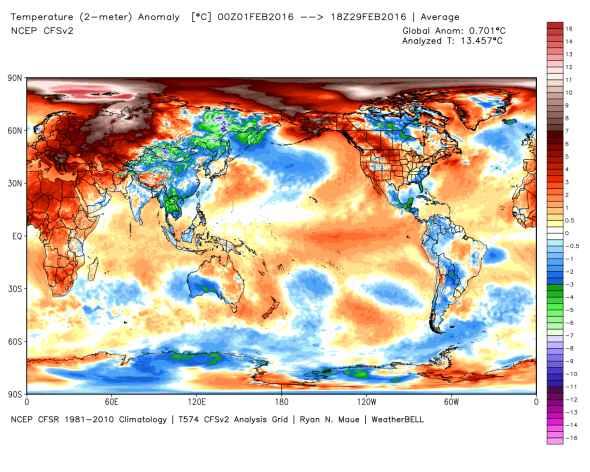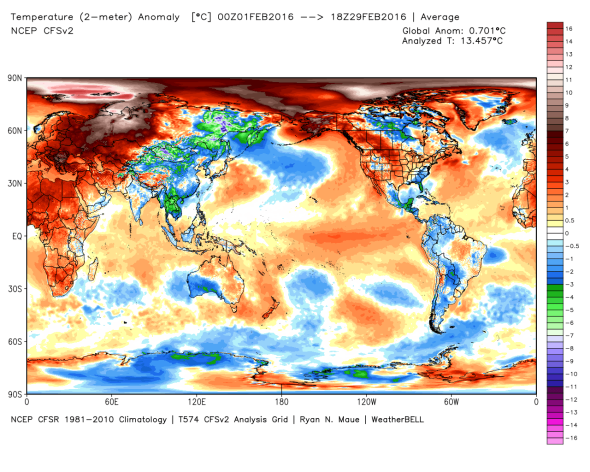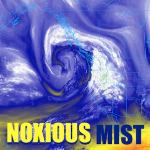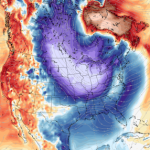Our Hemisphere’s Temperature Just Reached a Terrifying Milestone

Update, March 3, 2016: Since this post was originally published, the heat wave has continued. As of Thursday morning, it appears that average temperatures across the Northern Hemisphere have breached the 2 degrees Celsius above “normal” mark for the first time in recorded history, and likely the first time since human civilization began thousands of years ago.* That mark has long been held (somewhat arbitrarily) as the point above which climate change may begin to become "dangerous" to humanity. It's now arrived—though very briefly—much more quickly than anticipated. This is a milestone moment for our species. Climate change deserves our greatest possible attention.

Global temperatures hit a new all-time record high in February, shattering the old record set just last month amid a record-strong El Niño.
Ryan Maue/Weatherbell Analytics
Original post, March 1, 2016: Our planet’s preliminary February temperature data are in, and it’s now abundantly clear: Global warming is going into overdrive.
There are dozens of global temperature datasets, and usually I (and my climate journalist colleagues) wait until the official ones are released about the middle of the following month to announce a record-warm month at the global level. But this month’s data is so extraordinary that there’s no need to wait: February obliterated the all-time global temperature record set just last month.
Using unofficial data and adjusting for different base-line temperatures, it appears that February 2016 was likely somewhere between 1.15 and 1.4 degrees warmer than the long-term average, and about 0.2 degrees above last month—good enough for the most above-average month ever measured. (Since the globe had already warmed by about +0.45 degrees above pre-industrial levels during the 1981-2010 base-line meteorologists commonly use, that amount has been added to the data released today.)
Keep in mind that it took from the dawn of the industrial age until last October to reach the first 1.0 degree Celsius, and we’ve come as much as an extra 0.4 degrees further in just the last five months. Even accounting for the margin of error associated with these preliminary datasets, that means it’s virtually certain that February handily beat the record set just last month for the most anomalously warm month ever recorded. That’s stunning.
It also means that for many parts of the planet, there basically wasn’t a winter. Parts of the Arctic were more than 16 degrees Celsius (29 degrees Fahrenheit) warmer than “normal” for the month of February, bringing them a few degrees above freezing, on par with typical June levels, in what is typically the coldest month of the year. In the United States, the winter was record-warm in cities coast to coast. In Europe and Asia, dozens of countries set or tied their all-time temperature records for February. In the tropics, the record-warmth is prolonging the longest-lasting coral bleaching episode ever seen.
Incredible #Arctic warmth so far this year as sea ice continues to break daily records! #climate pic.twitter.com/Sl5o5IiZWp
— Zack Labe (@ZLabe) February 26, 2016
The northernmost permanent settlement, Norway’s Svalbard archipelago, has averaged 10 degrees Celsius (18 degrees Fahrenheit) above normal this winter, with temperatures rising above the freezing mark on nearly two dozen days since Dec. 1. That kind of extremely unusual weather has prompted a record-setting low maximum in Arctic sea ice, especially in the Barents Sea area north of Europe.
The data for February is so overwhelming that even prominent climate change skeptics have already embraced the new record. Writing on his blog, former NASA scientist Roy Spencer said that according to satellite records—the dataset of choice by climate skeptics for a variety of reasons—February 2016 featured “whopping” temperature anomalies especially in the Arctic. Spurred by disbelief, Spencer also checked his data with others released today and said the overlap is “about as good as it gets.” Speaking with the Washington Post, Spencer said the February data proves “there has been warming. The question is how much warming there’s been.”
Of course, all this is happening in the context of a record-setting El Niño, which tends to boost global temperatures for as much as six or eight months beyond its wintertime peak—mainly because it takes that long for excess heat to filter its way across the planet from the tropical Pacific Ocean. But El Niño isn’t entirely responsible for the absurd numbers we’re seeing. El Niño’s influence on the Arctic still isn’t well-known and is likely small. In fact, El Niño’s influence on global temperatures as a whole is likely small—on the order of 0.1 degree Celsius or so.
So what’s actually happening now is the liberation of nearly two decades’ worth of global warming energy that’s been stored in the oceans since the last major El Niño in 1998.
Watch out! Satellite data shows Feb setting crazy heat records. 'Whopping,' says Dr. Spencer https://t.co/eL8ysTcF9J pic.twitter.com/xqGJP3yNdz
— Bill McKibben (@billmckibben) March 1, 2016
Numbers like this amount to a step-change in our planet’s climate system. Peter Gleick, a climate scientist at the Pacific Institute in Oakland, California, said it’s difficult to compare the current temperature spike: “The old assumptions about what was normal are being tossed out the window … The old normal is gone.”
Almost overnight, the world has moved within arm’s reach of the climate goals negotiated just last December in Paris. There, small island nations on the front line of climate change set a temperature target of no more than 1.5 degrees Celsius rise by the year 2100 as a line in the sand, and that limit was embraced by the global community of nations. On this pace, we may reach that level for the first time—though briefly—later this year. In fact, at the daily level, we’re probably already there. We could now be right in the heart of a decade or more surge in global warming that could kick off a series of tipping points with far-reaching implications on our species and the countless others we share the planet with.
*Correction, March 4, 2016: Due to a data error at Weatherbell Analytics, the graphic added in the March 3 update to this post showed that in recent days, the temperature had reached approximately 2.5 degrees Celsius above pre-industrial levels. The graphic has been replaced with an updated version showing a less dramatic temperature spike, to approximately 2 degrees Celsius above preindustrial levels, though still exceeding 2 degrees Celsius when measured from pre-industrial levels. This spike has been reproduced in a separate dataset, so there remains high confidence that the 2-degree level was breached.
Future Tense is a partnership of Slate, New America, and Arizona State University.












































































































































Leave a Reply